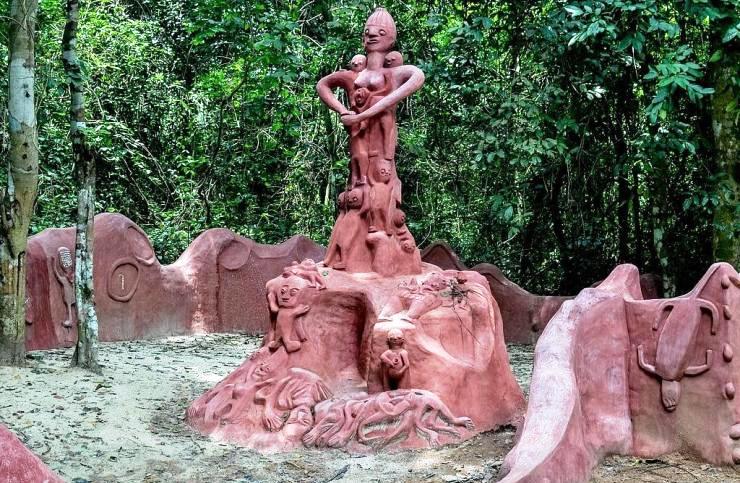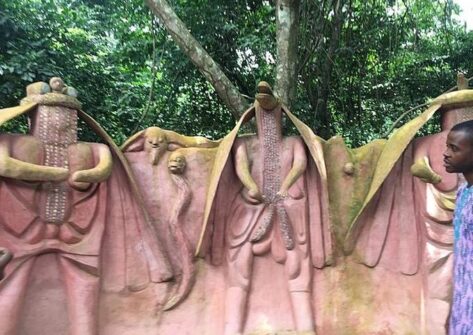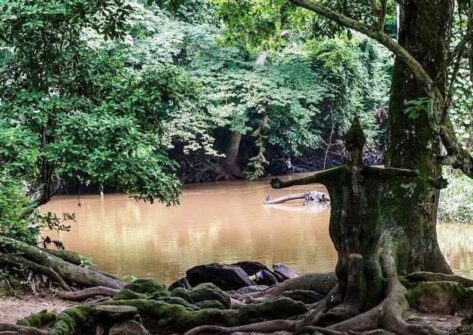Nigeria. Osun-Osogbo, the Last Sacred Forest of the Yoruba.

Northeast of Lagos (Nigeria), near the city of Osogbo (also spelled Oshogbo), the last sacred forest of the Yoruba culture resists the advance of time and ‘civilization’. We are talking about Osun-Osogbo, a suggestive place, where the force of wild nature coexists with the beauty of art shaped by the human being.
According to historical and archaeological research, the city of Osogbo was founded in the 18th century, along the Osun River. It is on the banks of this waterway that we find the sacred forest of the same name as the river, declared a national monument by the Nigerian government in 1965. Due to its cultural and natural relevance, UNESCO added it to the list of World Heritage Sites in 2005.
This one-of-a-kind site represents one of the last areas of primary forest in southern Nigeria. This means that the natural ecosystem has not undergone any modifications or interventions by man, as has happened in many other neighbouring areas.
The Osun Forest preserves hundreds of plant species, including numerous plants with medicinal properties.

Ancient masquerades at Osun-Osogbo sacred grove. CC BY-SA 4.0/ Cheeka 2.0
This verdant Eden and the river of the same name that flows through the trees bear the name of Osun, one of the gods sacred to the Yoruba. Osun is the protector of waterways, and the forest is the place where her spirit dwells. Precisely because of its sacredness, in this habitat, the Yoruba have erected sanctuaries, magnificent sculptures and surprising works of art, which integrate harmoniously with the arboreal world.
It is a unique space of its kind, an expression of the Yoruba culture through which a bridge is created between the natural world and the divine dimension. This sort of ‘invisible bridge’ acts as a protection for the forest itself, where hunting and fishing are strictly prohibited, even agriculture, as well, of course, as the felling of trees.
According to myth, the forest was discovered and inhabited by the population who later founded the town of Osogbo. This happened over 600 years ago, at a time when – as the myth says – the inhabitants of Osogbo saw Osun, the Yoruba deity protector of waterways.
In addition to giving its name to the river that flows through the region, Osun is represented in the sculptures and artistic works found in the forest. Osun is portrayed as a sort of mermaid, testifying to her bond with the water element.

River-side Shrine and Sacred Grove of Oshun. CC BY-SA 4.0/ChuksToluObu
The Osun Forest encompasses all this and more. It is not only relevant from a naturalistic-ecological point of view, but also from a historical and cultural point of view. For the Yoruba, it represents a sacred space, where the past joins the present. In fact, alongside archaic works of art, more recent sculptures can be admired, specially made during the twentieth century.
Through these artistic expressions, the Yoruba peoples strengthen the bond with the pantheon of deities typical of their tradition and, at the same time, create an invisible thread that unites the old and new generations and the descendants of the diaspora.
Although they have now embraced Christianity or the Muslim faith, many Yoruba still follow some practices related to their ancestral traditions. It can be said that the Yoruba culture is also a philosophical and cosmological system, in which at the centre we find a complex pantheon of divinities, where a supreme creator and hundreds of divinities and minor spirits hold sway.
The Haitian voodoo, the Brazilian candomblé and the Cuban santeria derive from this complex system. Here the forest of Osun – through its green and artistic spaces, with all their symbolism – represents a site that recomposes the strands of yesterday and today in the Yoruba culture. (Open Photo: A statue signifying the maternity nature of Iya Osun at the sacred grove of Osun. CC BY-SA 4.0/Hammed Usman)
Silvia C. Turrin/SMA



